Klue Compete
The Competitive Enablement Platform
Learn More
FIND OUT MORE >

Over the years, we’ve seen a lot of product marketers launch their company’s competitive enablement program.
And we’ve also seen a lot of the struggles they go through. When the pressure is on to prove the value of your program, oftentimes product marketers fall into one of two categories:
Those that believe that more information is the solution to their competitive battle.
That one more YouTube video, blog post, or website metric is going to unlock the secrets of their competitor’s strategy. They prioritize collecting as much external data as possible so that they always know the most information about their competitors.
But… quantity ≠ quality. These are the same teams that provide information dumps to the entire org with no context attached to it. Is a flood of disparate news really helping your business outperform competitors?
Those who recognize that managing a competitive enablement program is about creating – and communicating – an effective strategy.
It isn’t simply knowing the most about your competitor, but being the most effective at activating a playbook on how to beat them. They build a plan and then prove that their competitive program is actually influencing revenue.
And these product marketers that are actually proving that their competitive program is impacting revenue? They’re the ones that adopt a sales-first approach to competitive enablement. Here are five reasons that they choose to do so.
The three most important financial levers that impact revenue growth are acquisition, retention, and monetization (upselling). However, in order to retain customers and grow these accounts, you need to get them in the door in the first place.
That’s why the first step of your competitive program should be to enable sales. When you provide the team with intel that clearly articulates how you stack up against competitors and your own value propositions, sellers are better able to find strong customer-fits when prospecting and pitching.
This way your sales teams are not only able to acquire customers to help increase revenue, but they also acquire the right first-time buyers.
This will better setup your customer success and support teams to build a quality relationship, which ultimately helps the retention and growth of these accounts.
Data from the 2021 Competitive Enablement Report indicates that teams across the entire organization agree with the importance of supporting sales. When asked what they expected to see from their company’s investment in competitive intelligence, stakeholders rated improving sales performance as the greatest benefit.


One of the biggest difficulties that competitive programs face is demonstrating their impact on ROI for the business. Meanwhile, sellers are the main influencers that drive revenue and their performance is measured by metrics on a consistent basis.
By supporting salespeople with better competitive data, an improvement in their performance and your entire team’s competitive win-rates can then make the case for the influence of your competitive program.
But… even then, that’s not an exact science.
Let’s say Suzy happened to crush last quarter. Is that because of the competitive intelligence she worked with? Not necessarily – she might’ve built a stronger rapport with prospects or the product she’s selling rolled out a great new feature.
An even more accurate way to measure the value of competitive intelligence being provided is to look at the lift in the performance of your sales reps that use the content and battlecards provided versus those that don’t during competitive deals.
This is a critical part of Klue’s ‘Impact Analysis’, where we like to go even further and attach a dollar amount to this measurement. For example, sales reps that used your battlecards on a competitor won 45% of their deals, but the reps that didn’t use your battlecards only closed 36% of their deals.
Sure, a sales rep not using your battlecards being 9% less likely to close deals seems somewhat significant. But how much does that impact revenue over an entire year if your reps face 55 competitive opportunities per quarter and your average deal size is $200,000?
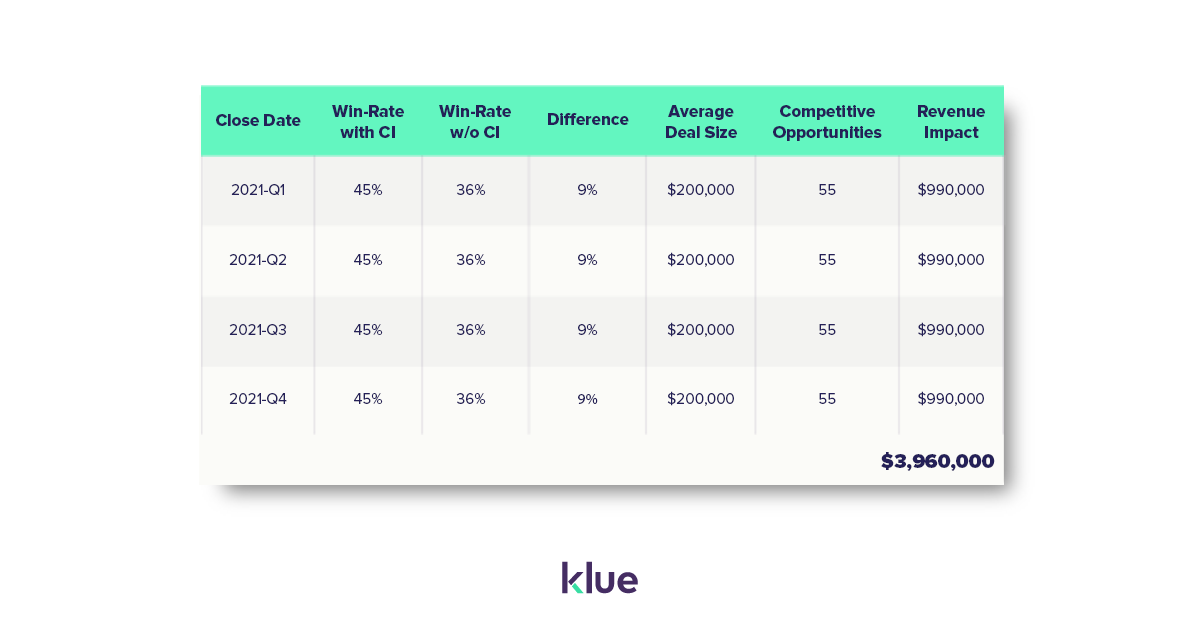

By measuring the performance of sales reps that used competitive intel against those who didn’t, you can attribute $3,960,000 of lost revenue to teams not turning to competitive intelligence during a deal.
Now, that’s a number that gets attention.
These are metrics that serve as far clearer indicators of your program’s impact than providing high-level competitive landscapes and matrixes to your executive team.
Sales teams want competitive intel more than any other department in the company. They’re talking with prospective clients on a daily basis, and inevitably in those conversations, they’ll need to position themselves against the competition.
Results from the report show that salespeople at high-growth companies are particularly hungry for competitive intelligence, and are being supported by their competitive team first almost 70% of the time.
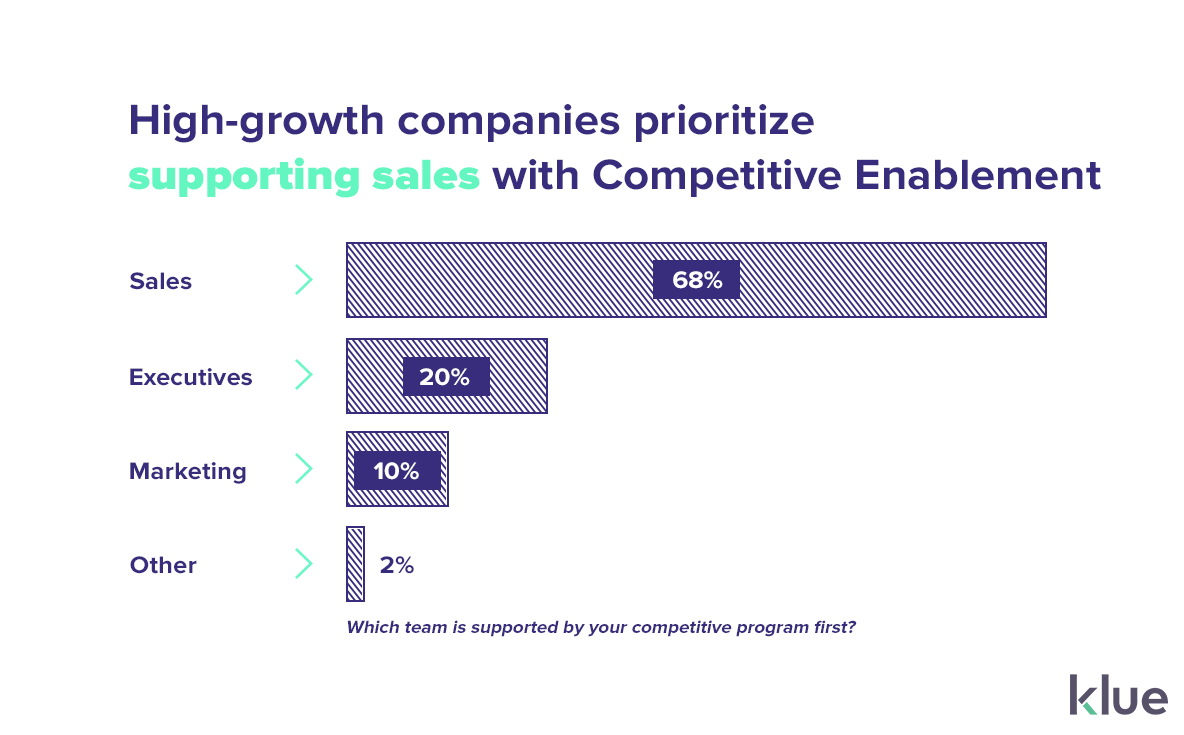

Sales leaders want to be served competitive intelligence and they expect their competitive programs to help improve the performance of the team. But as Jenna Dorman, VP of Strategic Accounts at Alida, explains, for competitive intel to be worthwhile then it needs to have a clear process so that information is accurate, reliable, and not a burden for salespeople to deal with.
“Your competitive intelligence system has to continually evolve. There’s always going to be that basic information as you see a competitor more frequently… but how do you capture that information and make it more rich?
Oftentimes the information that is presented is the bare minimum and there isn’t the area to add the stories from the field. Hearing that win-loss story, or the reps anecdotal experience of fighting that competitor, or having access to the key assets that helped them win a deal. Those things shouldn’t all live in different places as it creates a black market of content.”
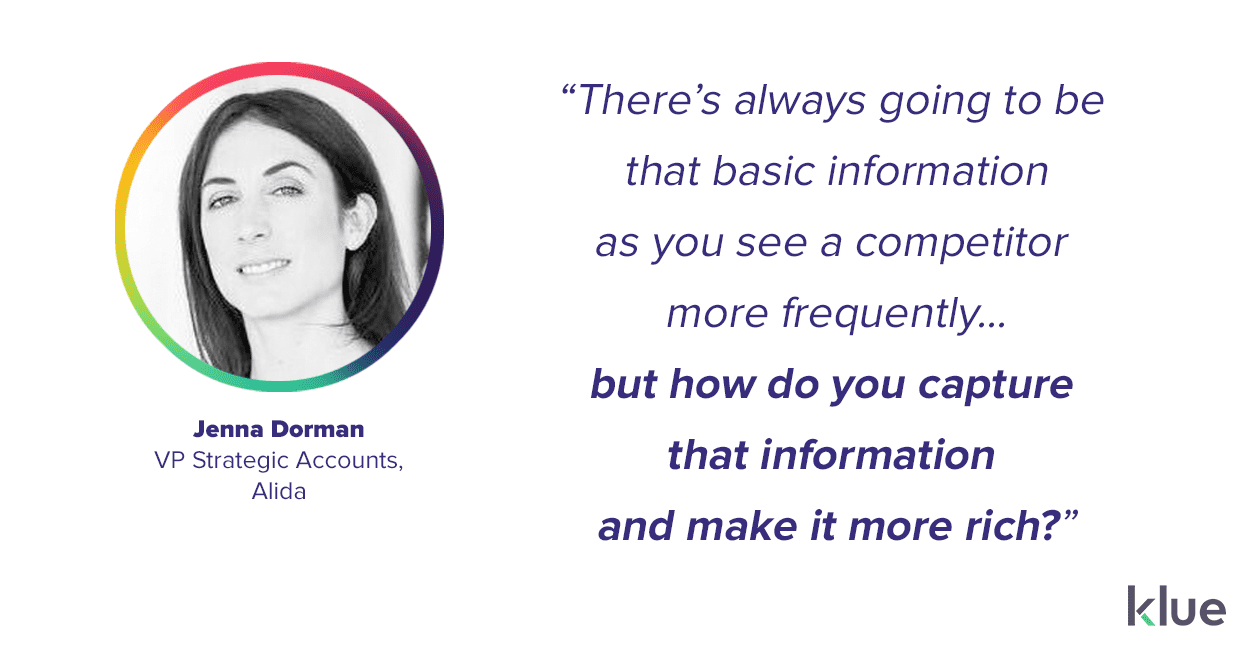

Although teams across the business can benefit from competitive enablement, sales teams are under the most pressure to access competitive insights quickly.
Even in a sales cycle that lasts months, an Account Executive can lose that deal in a matter of seconds. The moment that they tell a prospective customer incorrect information about a competitor or how their own product stacks up…
Poof. Deal dead.
It’s crucial in customer-facing roles that the information you share about competitors is correct, otherwise, you’ll lose all credibility.
In many cases, sales teams that aren’t supported with competitive intelligence also don’t have a clear idea of their most direct competitors. Sure, reps are sharing anecdotal stories, but there isn’t a systemized process to understand who is impacting your revenue the most.
By supporting sales and ensuring that they’re flagging every time a competitor is in a deal and whether they won or lost, your competitive program should quantify which competitors are appearing the most frequently, and the rate at which they are beating you in a competitive deal.
With this information, we like to build out a ‘Threat Analysis’ that maps out the competitors that are the biggest disruptors to the business.
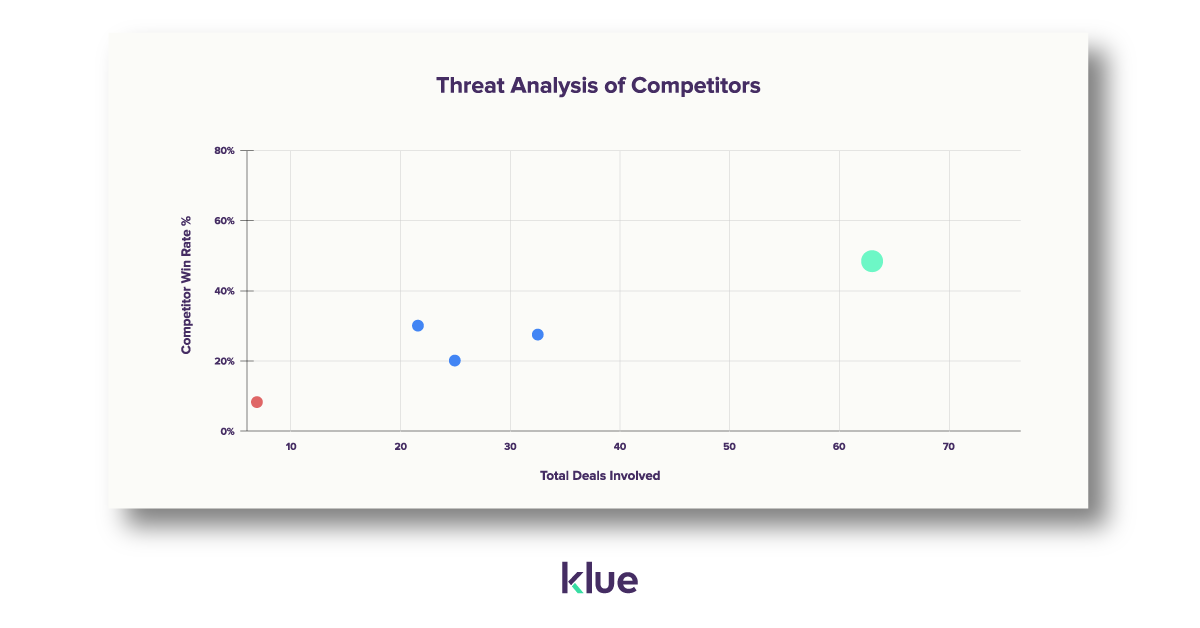

A Threat Analysis like this is a strong strategic asset for the sales team and your competitive program. These results show who you should be spending the most time digging on, and also who sales reps should be aware of during deals.
When your sales teams are enabled with competitive intelligence and they are actively mentioning who they are up against, your competitive program will be able to provide leaders with a clear picture of their competitive landscape.
Let’s be real, sales have the loudest voice in the room. And this isn’t meant to be an insult!
Sales leaders are an indispensable part of the company, and even more importantly, have got a seat at the table. They’ve got power with decision-makers over where resources and money can get allocated.
Those in charge of competitive enablement teams on the other hand aren’t always afforded that luxury. Data from the 2021 Competitive Enablement Report shows that only 2% of less-mature competitive programs have full support from the executive team.
(Hint, hint, a good relationship with sales leaders will make your life a whole lot easier. They’re like the kid at school whose parents always packed them the best lunches. Everyone in their right mind wants to buddy up with them, and if you’re lucky you’ll get a share of the spoils.)
Rob Begg, VP of Product Marketing at Salesforce, noted just how important it is to bring sales in as allies. If sales leaders point to a competitive problem as the reason they’re not hitting targets and you’ve presented yourself well to ease that burden, the company will rally resources.
“If you take out the CEO, senior sales leadership has the most power to get competitive intelligence focused on.
Having a top-down sales demand for something. Nothing gets action more than that.”
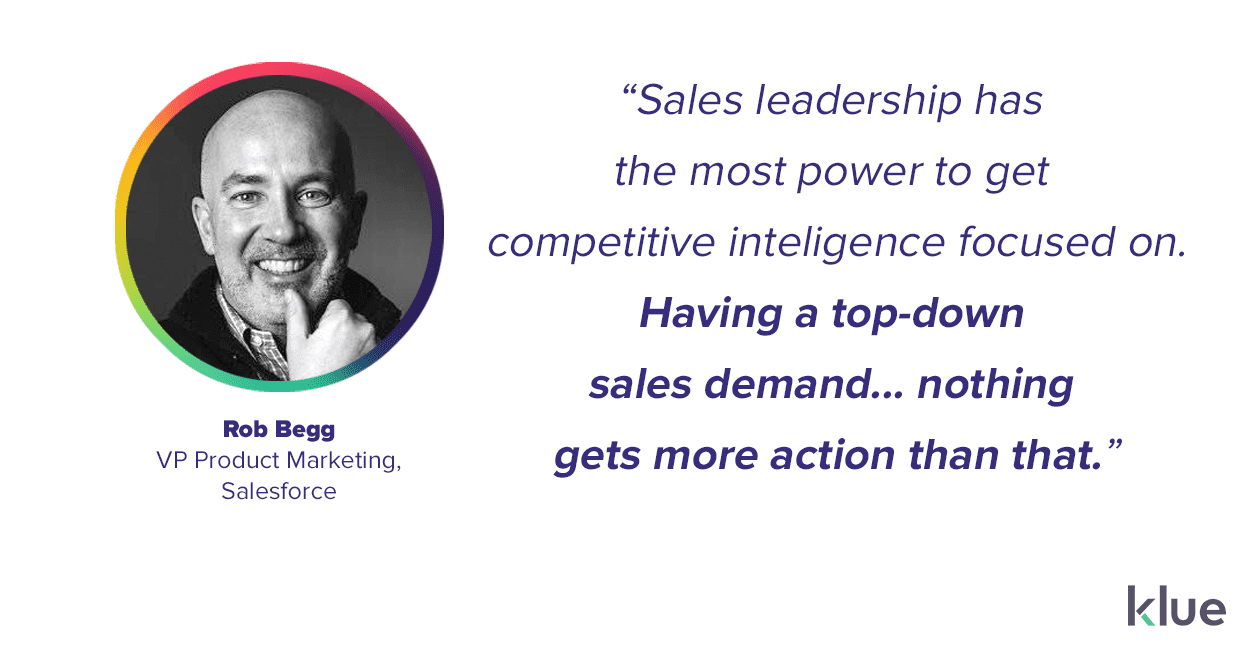

Sales are also an important ally as they’re often the greatest source of competitive intelligence in the company. They have a window into what your competitors are saying to customers on a daily basis.
If you can build a strong relationship with the sales team, they’ll be more likely to share those juicy nuggets of intel with your competitive enablement program instead of letting it sit in the minds of a few.
Competitive enablement teams need to make an impression with decision-makers, and the best way to do so is by pointing to revenue metrics that show just how much you’ve managed to affect the bottom line.
By enabling your revenue teams, starting with sales and then those in charge of retention and account expansion, your competitive program can prove tangible impact on the ROI to the business.


Competitive Enablement
The topic of Large Language Models (LLMs) has a lot of confusion. Here's what you need to know about how Klue is working with them.


Competitive Enablement
Product Marketing
If your competitive intel game is too strong for automation, too pure for data privacy, and too rebellious for accuracy — then Klue AI is probably not for you.


Let’s do it. Tell us a bit about yourself and we’ll set up a time to wow you.
Let's do it. Tell us a bit about yourself and we'll set up a time to wow you.
XLet's do it. Tell us a bit about yourself and we'll set up a time to wow you.
XSubscribe to get our latest AI functionality and news in your inbox.
XOur Buyer Pulse feature, set to launch in Q2 2024, offers valuable insights into the factors influencing buyer decisions in your pipeline. By signing up for the waitlist, we can better gauge interest and proactively engage with you to streamline the setup and integration process before the feature becomes widely available.
X